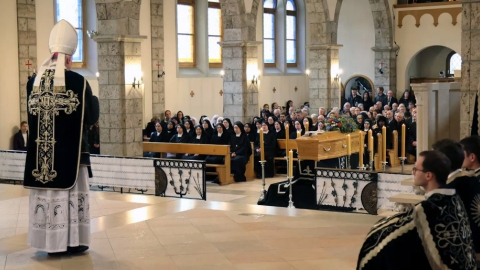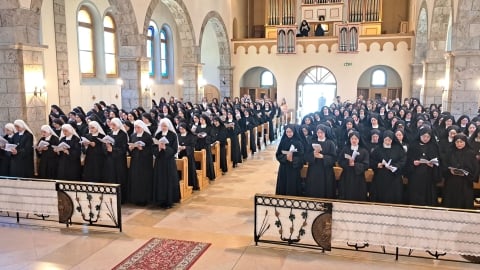Beseeching God's favor: the Rogation Days

Some words on the importance of observing the ancient days of Rogation just before the Feast of the Ascension.
Image above: a Rogation Day procession held at St. Thomas Aquinas Seminary in Winona, Minnesota. See a photo gallery here >
Preceding the celebration of the Ascension of Our Lord Jesus Christ on Thursday, the Minor Rogation Days (or Lesser Litanies)* of Monday, Tuesday and Wednesday provide us the opportunity to beseech God's forgiveness for man's transgressions and His blessings for a bountiful harvest. In connection with these Rogation Days, we offer here some insights on their associated liturgical practices from Dom Gueranger's The Liturgical Year and the The Catholic Encyclopedia. See also the comments that we previously provided from Fr. Goffine's The Church's Year.
*NB: the Major Rogation Days, or Greater Litanies, are observed in conjunction with the Feast of St. Mark on April 25th.
The Rogation Days
Except from The Liturgical Year
Dom Gueranger, O.S.B.
This day is honored in the Liturgy by what is called St. Mark’s Procession. The term, however, is not a correct one, inasmuch as a procession was a privilege peculiar to April 25 previously to the institution of our Evangelist’s feast, which even so late as the sixth century had no fixed day in the Roman Church. The real name of this procession is The Greater Litanies. The word Litany means Supplication, and is applied to the religious rite of singing certain chants whilst proceeding from place to place in order to propitiate heaven. The two Greek words Kyrie eleison (Lord, have mercy on us) were also called Litany, as likewise were the invocations which were afterwards added to that cry for mercy, and which now form a liturgical prayer used by the Church on certain solemn occasions.
The Greater Litanies (or processions) are so called to distinguish them from the Minor Litanies, that is, processions of less importance as far as the solemnity and concourse of the faithful were concerned. We gather from an expression of St. Gregory the Great that it was an ancient custom in the Roman Church to celebrate, once each year, a Greater Litany, at which all the clergy and people assisted. This holy Pontiff chose April 25 as the fixed day for this procession, and appointed the Basilica of St. Peter as the Station.
Several writers on the Liturgy have erroneously confounded this institution with the processions prescribed by St. Gregory for times of public calamity. It existed long before his time, and all that he did was to fix it on April 25. It is quite independent of the feast of St. Mark, which was instituted at a much later period. If April 25 occur during Easter week, the procession takes place on that day (unless it be Easter Sunday), but the feast of the Evangelist is not kept till after the octave.
The question naturally presents itself—why did St. Gregory choose April 25 for a procession and Station in which everything reminds us of compunction and penance, and which would seem so out of keeping with the joyous season of Easter? The first to give a satisfactory answer to this difficulty was Canon Moretti, a learned liturgist of the eighteenth century. In a dissertation of great erudition, he proves that in the 5th, and probably even in the 4th century, April 25 was observed at Rome as a day of great solemnity. The faithful went, on that day, to the Basilica of St. Peter, in order to celebrate the anniversary of the first entrance of the Prince of the Apostles into Rome, upon which he thus conferred the inalienable privilege of being the capital of Christendom. It is from that day that we count the 25 years, two months, and some days that St. Peter reigned as Bishop of Rome. The Sacramentary of St. Leo gives us the Mass of this solemnity, which afterwards ceased to be kept. St. Gregory, to whom we are mainly indebted for the arrangement of the Roman Liturgy, was anxious to perpetuate the memory of a day which gave to Rome her grandest glory. He therefore ordained that the Church of St. Peter should be the Station on that auspicious day. April 25 comes too frequently during the octave of Easter that it could not be kept as a feast, properly so called, in honor of St. Peter’s entrance into Rome; St. Gregory, therefore, adopted the only means left of commemorating the great event.
But there was a striking contrast resulting from this institution, of which the holy Pontiff was fully aware, but which he could not avoid: it was the contrast between the joys of Paschal Time and the penitential sentiments wherewith the faithful should assist at the procession and Station of the Great Litany. Laden as we are with the manifold graces of this holy season, and elated with our Paschal joys, we must sober our gladness by reflecting on the motives which led the Church to cast this hour of shadow over our Easter sunshine. After all, we are sinners, with much to regret and much to fear; we have to avert those scourges which are due to the crimes of mankind; we have, by humbling ourselves and invoking the intercession of the Mother of God and the Saints, to obtain the health of our bodies, and the preservation of the fruits of the earth; we have to offer atonement to divine justice for our own and the world’s pride, sinful indulgences, and insubordination. Let us enter into ourselves, and humbly confess that our own share in exciting God’s indignation is great; and our poor prayers, united with those of our holy Mother the Church, will obtain mercy for the guilty, and for ourselves who are of the number.
A day, then, like this, of reparation to God’s offended majesty, would naturally suggest the necessity of joining some exterior penance to the interior dispositions of contrition which filled the hearts of Christians. Abstinence from flesh meat has always been observed on this day at Rome; and when the Roman Liturgy was established in France by Pepin and Charlemagne, the Great Litany of April 25 was, of course, celebrated, and the abstinence kept by the faithful of that country. A Council of Aix-la-Chapelle, in 836, enjoined the additional obligation of resting from servile work on this day: the same enactment is found in the Capitularia of Charles the Bald. As regards fasting, properly so called, being contrary to the spirit of Paschal Time, it would seem never to have been observed on this day, at least not generally. Amalarius, who lived in the ninth century, asserts that it was not then practiced even in Rome.
During the procession, the Litany of the Saints is sung, followed by several versicles and prayers. The Mass of the Station is celebrated according to the Lenten Rite, that is, without the Gloria in excelsis, and in violet vestments.
We take this opportunity of protesting against the negligence of Christians on this subject. Even persons who have the reputation of being spiritual think nothing of being absent from the Litanies said on St. Mark’s and the Rogation Days. One would have thought that when the Holy See took from these days the obligation of abstinence, the faithful would be so much the more earnest to join in the duty still left—the duty of prayer. The people’s presence at the Litanies is taken for granted: and it is simply absurd that a religion rite of public reparation should be one from which almost all should keep away. We suppose that these Christians will acknowledge the importance of the petitions made in the Litanies; but God is not obliged to hear them in favor of such as ought to make them and yet do not. This is one of the many instances which might be brought forward of the strange delusions into which private and isolated devotion is apt to degenerate. When St. Charles Borromeo first took possession of his see of Milan, he found this negligence among his people, and that they left the clergy to go through the Litanies of April 25 by themselves. He assisted at them himself, and walked barefooted in the procession. The people soon followed the sainted pastor’s example.
Except from The Catholic Encyclopedia
Days of prayer, and formerly also of fasting, instituted by the Church to appease God's anger at man's transgressions, to ask protection in calamities, and to obtain a good and bountiful harvest, known in England as "Gang Days" [from the Anglo-Saxon phrase "to go"] and "Cross Week", and in Germany as Bittage, Bittwoche, Kreuzwoche. The Rogation Days were highly esteemed in England and King Alfred's laws considered a theft committed on these days equal to one committed on Sunday or a higher Church Holy Day. Their celebration continued even to the 13th year of Elizabeth, 1571, when one of the ministers of the Established Church inveighed against the Rogation processions, or Gang Days, of Cross Week. The ceremonial may be found in the Council of Clovesho (Thorpe, Ancient Laws, I, 64; Hefele, Conciliengeschichte, III, 564).
The Rogation Days are the 25th of April, called Major, and the three days before the feast of the Ascension, called Minor. The Major Rogation, which has no connection with the feast of St. Mark (fixed for this date much later) seems to be of very early date and to have been introduced to counteract the ancient Robigalia, on which the heathens held processions and supplications to their gods. St. Gregory the Great (d. 604) regulated the already existing custom. The Minor Rogations were introduced by St. Mamertus, Bishop of Vienne, and were afterwards ordered by the Fifth Council of Orleans, which was held in 511, and then approved by Leo III (795-816). This is asserted by St. Gregory of Tours in Hist. Franc., II, 34, by St. Avitus of Vienne in his Hom. de Rogat. (P.L., LVIII, 563), by Ado of Vienne (P.L., CXXIII, 102), and by the Roman Martyrology. Sassi, in Archiepiscopi Mediolanenses, ascribes their introduction at an earlier date to St. Lazarus. This is also held by the Bollandist Henschen in "cta SS., II, Feb., 522. The liturgical celebration now consists in the procession and the Rogation Mass. For April 25 the Roman Missal gives the rubric: "If the feast of St. Mark is transferred, the procession is not transferred. In the rare case of April 25 being Easter Sunday [as it was in 1886, 1943], the procession is held not on Sunday but on the Tuesday following".
The order to be observed in the procession of the Major and Minor Rogation is given in the Roman Ritual, title X, ch. iv. After the antiphon "Exsurge Domine", the Litany of the Saints is chanted and each verse and response is said twice. After the verse "Sancta Maria" the procession begins to move. If necessary, the litany may be repeated, or some of the Penitential or Gradual Psalms added. For the Minor Rogations the Ceremoniale Episcoporum, book II, ch. xxxii, notes: "Eadem serventur sed aliquid remissius". If the procession is held, the Rogation Mass is obligatory, and no notice is taken of whatever feast may occur, unless only one Mass is said, for then a commemoration is made of the feast. An exception is made in favor of the patron or titular of the church, of whom the Mass is said with a commemoration of the Rogation. The color used in the procession and Mass is violet. The Roman Breviary gives the instruction: "All persons bound to recite the Office, and who are not present at the procession, are bound to recite the Litany, nor can it be anticipated".





